Settings
Automation
It represents the control center for intelligent automation of customer service processes, enabling the creation, management, and monitoring of automation rules that replace and optimize manual processes. This comprehensive tool enables organizations to implement automated workflows that improve operational efficiency and allow teams to focus on higher-value tasks.
The interface is structured in an organized table layout that presents all automation rules in a clear and accessible manner, providing a comprehensive view of the operational status of the automation system.
├── Header
│ ├── Action Button: “Add Automation Rule”
├── Rule Management Table
│ ├── Name: Automation Rule Identifier
│ ├── Description: Rule context and purpose
│ ├── Active: Enable/Disable status
│ ├── Created on: Rule creation date
│ ├── Action Buttons
│ │ ├── Edit
│ │ ├── Clone: Rule duplication for variations
│ │ ├── Delete
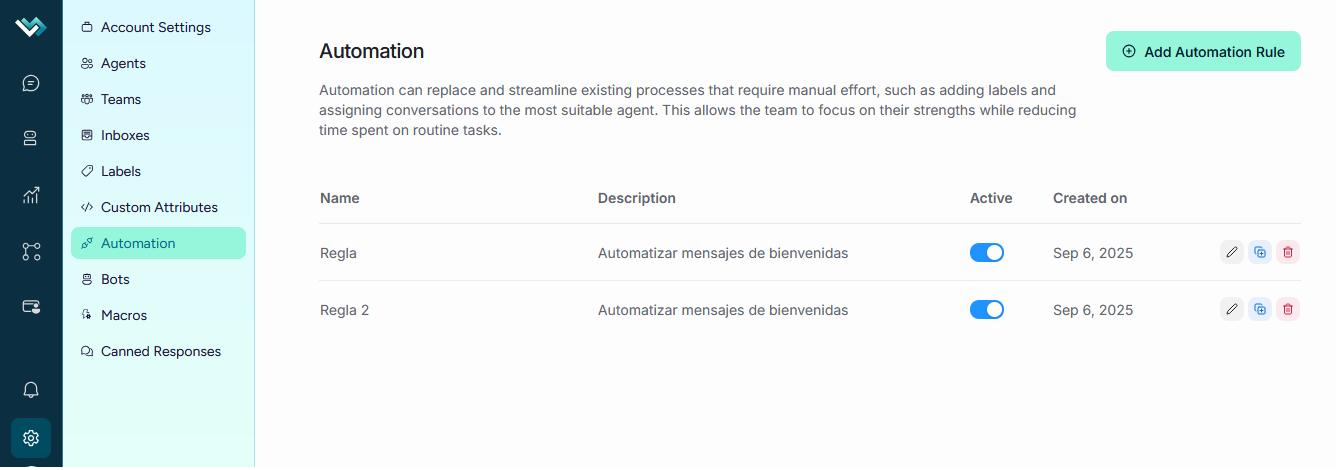
Creating/Editing Automation Rules.
Advanced Creation/Editing Mode.
→ Basic rule Configuration:
- Rule name: Required field to identify the rule
- Description: Free-text field to document the purpose and context
- Trigger Event: Selector that determines when the automation runs
→ Trigger event system:
- Conversation created: Triggered when a new conversation is created
- Conversation updated: Triggered when an existing conversation is modified
- Message created: Triggered when a new message is received
- Conversation open: Triggered when an agent opens a conversation
Advanced condition system
Visual condition builder
The system provides a visual builder that allows you to define complex conditions using an intuitive interface:
→ Available attribute types:
- Conversation Attributes: Status, Priority, Assignee, Team, Tags, Language
- Contact Attributes: Email, Phone Number, Country, Browser Language
- Message Attributes: Message Type, Content, Email Subject
- Custom Attributes: Custom fields defined by the organization
→ Condition operators filtering:
- Equals: Exact value matching
- Contains: Text search within content
- Does not contain: Exclusion of specific content
- Is empty: Verification of fields without values
- Is not empty: Verification of fields with values
- Greater than/Less than: Numeric and date comparisons
→ Dynamic value system:
- Multiple selection: For tags, teams, and agents
- Selective search: For specific contacts and conversations
- Text entry: For custom content searches
- Date picker: For specific time ranges
- Boolean selector: For true/false values
Automated actions system. Library of Available Actions
The system offers a wide range of actions that can be executed automatically:
→ Assignment Actions:
- Assign to agent: Automatic assignment to specific agents
- Assign to team: Automatic distribution between teams
- Change priority: Automatic modification of the priority level
→ Tagging actions:
- Add label: Automatic application of Specific Labels
- Remove label: Automatic label removal
→ Communication actions:
- Send email to Team: Automatic email notifications
- Send email Transcript: Automatic conversation sending
- Send message: Predefined auto-replies
- Send attachment: Automatic file sending
→ Conversation management actions:
- Mute conversation: Automatically pause notifications
- Snooze conversation: Schedule follow-up later
- Resolve conversation: Automatically close conversations
- Send webhook event: Integrate with external systems
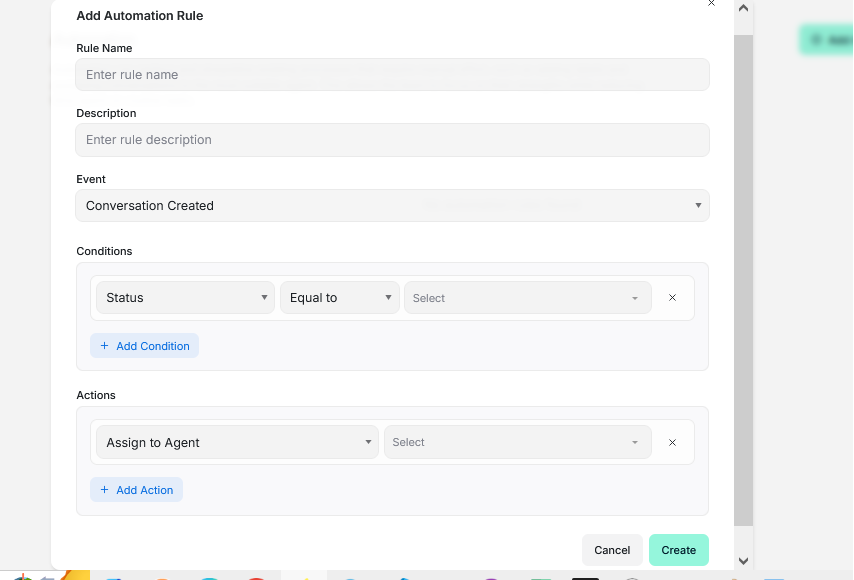
Intelligent Activation/Deactivation system
State Control with confirmation
The system implements robust state control that includes:
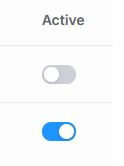
→ Activation process:
- Activation confirmation: Modal that confirms the rule activation
- Contextual description: Information about the impact of the activation
- User confirmation: Requires explicit confirmation

→ Deactivation process:
- Deactivation confirmation: Modal that confirms the deactivation
- Impact warning: Information about the consequences
- Configuration preservation: Preservation of the configuration for reactivation
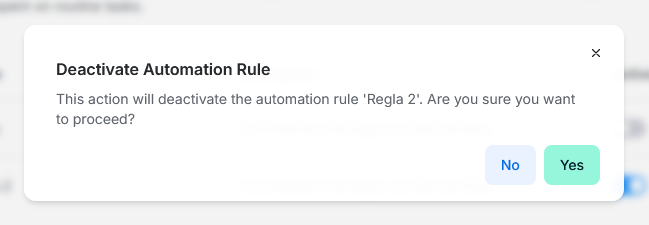
Efficient cloning system. Intelligent rule duplication
To facilitate the creation of variations of existing rules:
Cloning Process:
- Full duplication: Copy of all conditions and actions
- Configuration preservation: Maintains the original logic
- Post-customization: Ability to modify the cloned rule

Automatic sync
- Attribute sync: Automatic integration with custom attributes
- Team support: Integration with organizational structure
Plan support
- No quantity restrictions: Unlimited automation rule creation
- Full integration: Full functionality with no plan limitations
Use Case 1: E-commerce - Automatic Escalation by Order Value
Scenario: An online store that needs to automatically escalate VIP customer inquiries.
1. VIP customer creates a conversation with an order > $1,000.
2. System automatically detects conditions.
3. Applies VIP, high-value, and escalated labels.
4. Changes priority to urgent.
5. Assigns to the VIP Support team.
6. Notifies the dedicated team via email.
Use Case 2: SaaS - Automatic Keyword Classification
Scenario: A software company that automatically classifies technical inquiries.
1. Customer sends a message with technical keywords
2. System analyzes message content
3. Automatically applies technical tags
4. Assigns to technical support team
5. Increases priority to high
6. Sends automatic confirmation message
Use Case 3: Financial Services - Regulatory Compliance
Scenario: A bank that needs to automatically escalate high-risk inquiries
1. System detects a change in risk level
2. Evaluates compliance category
3. Applies risk and compliance tags
4. Escalates to specialized teams
5. Notifies external systems via webhook
6. Email alerts critical teams
Bots
It represents the control center for managing automated virtual agents, enabling the creation, configuration, and monitoring of bots that act as virtual members of the customer service team. This comprehensive tool allows organizations to deploy automated assistants that can handle initial inquiries, provide immediate responses, and transfer conversations to human agents when necessary.
├── Header
│ ├── Action Button: “Add Bot”
├── Bot Management Table
│ ├── Bot Details: Full information including name, description, and avatar
│ ├── Webhook URL: Bot integration endpoint
│ ├── Action Buttons
│ │ ├── Edit
│ │ ├── Delete
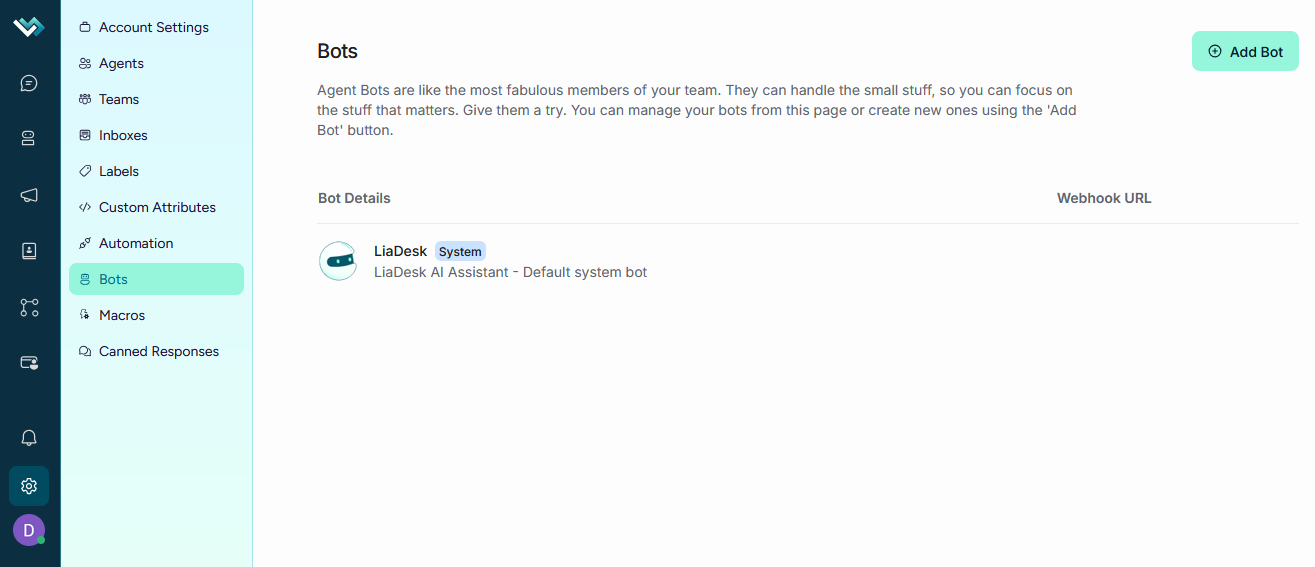
Bot Creation/Edition
├── Creation/Edition Modal
│ ├── Bot Avatar: Custom image upload system
│ ├── Bot Name: Required field to identify the bot
│ ├── Description: Free text field to document the purpose and capabilities
│ ├── Webhook URL: Required field for integration with external services
│ ├── Action Buttons
│ │ ├── Create/Edit
│ │ ├── Cancel
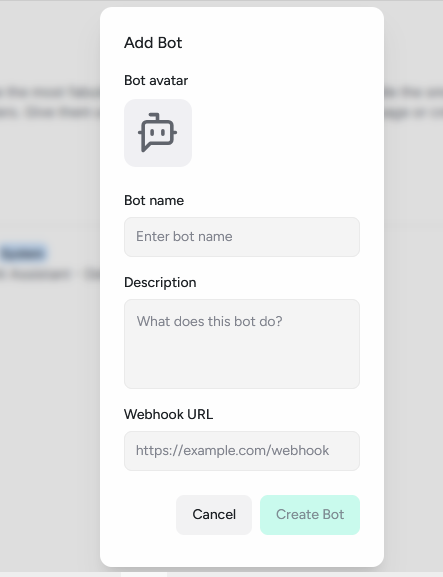
Validation system:
- Name validation: Verifies that the name is unique and descriptive
- URL validation: Verifies that the webhook format is valid (http:// or https://)
- Avatar validation: Image upload and management system
Integration with external services
The bot system relies on webhooks for integration with external services:
Webhook configuration:
- Webhook URL: Endpoint where events will be sent
- URL validation: Verifies format and accessibility
- Access token: Automatic generation of authentication tokens
Supported bot types:
- Webhook bot: Integration with custom services
- System bot: Global bot for the entire platform
Inbox Configuration System. Assigning Bots to Inboxes
The system allows you to assign specific bots to different communication channels:
Assignment process:
- Inbox selection: Select the channel where the bot will operate
- Bot selection: Assign a specific bot to the inbox
- Automatic configuration: Automatic application of the configuration
Assignment management:
- Assignment update: Change the bot assigned to an inbox
- Bot disconnection: Remove the bot from the inbox
- Assignment status: Visual indication of the active bot
Operational benefits for users
Intelligent automation
- Immediate response: Bots that instantly respond to queries
- Basic query handling: Automatic resolution of frequently asked questions
- Intelligent transfer: Automatic escalation to human agents when necessary
Operational efficiency
- Workload Reduction: Relief from repetitive tasks for agents
- 24/7 Availability: Continuous support without interruptions
- Scalability: Ability to handle multiple conversations simultaneously
Administrative control
- Centralized management: Full control over all bots
- Flexible configuration: Customization according to specific needs
- Real-time monitoring: Visibility into the status of all bots
Use Case 1: E-commerce
Scenario: An online store that needs to answer basic questions 24/7
1. Customer initiates a conversation in the website chat
2. Bot automatically detects an incoming message
3. System analyzes content and context
4. Bot generates a knowledge-based response
5. If it can't resolve the issue: Request escalation
6. Automatic handoff to a human agent
Example Conversation:
Customer: "How long does shipping take?"
Bot: "Standard shipping takes 3-5 business days. Express shipping takes 1-2 business days.
Would you like to know more about our shipping options?"
Customer: "I want to cancel my order."
Bot: "I understand you want to cancel your order. I'll connect you with a human agent who can help you with the cancellation."
[Handoff to human agent]
Use Case 2: SaaS - Onboarding and technical support bot
Scenario: A software company that needs to guide new users
1. New user contacts for the first time
2. Bot identifies experience level
3. Provides personalized getting started guide
4. Searches documentation for technical answers
5. Creates tickets for complex issues
6. Schedules demos for interested users
Example Conversation:
User: "I'm new, how do I get started?"
Bot: "Welcome! I'm going to guide you step by step. First, I need to know: do you already have an account created?"
User: "Yes, but I don't know how to set up integrations."
Bot: "Great. I'll show you how to set up integrations. First, go to Settings > Integrations. What type of integration do you need to set up?"
User: "Third-party API"
Bot: "To configure third-party APIs, you need to obtain the credentials of the external application. I'll connect you with our technical team for a detailed guide."
[Handoff to technical team]
Macros
It represents the control center for creating and managing automated action sequences, designed for agents and administrators to define sets of saved actions that facilitate the completion of repetitive tasks. This comprehensive tool allows agents to create customized workflows that can be executed with a single click, significantly improving operational efficiency and reducing the time spent on routine tasks.
├── Header
│ ├── Action Button: “Add a New Macro”
├── Macro Management Table
│ ├── Name
│ ├── Created By
│ ├── Last Updated By
│ ├── Visibility: Access Status (Public/Private)
│ ├── Action Buttons
│ │ ├── Save Macro/Edit
│ │ ├── Delete
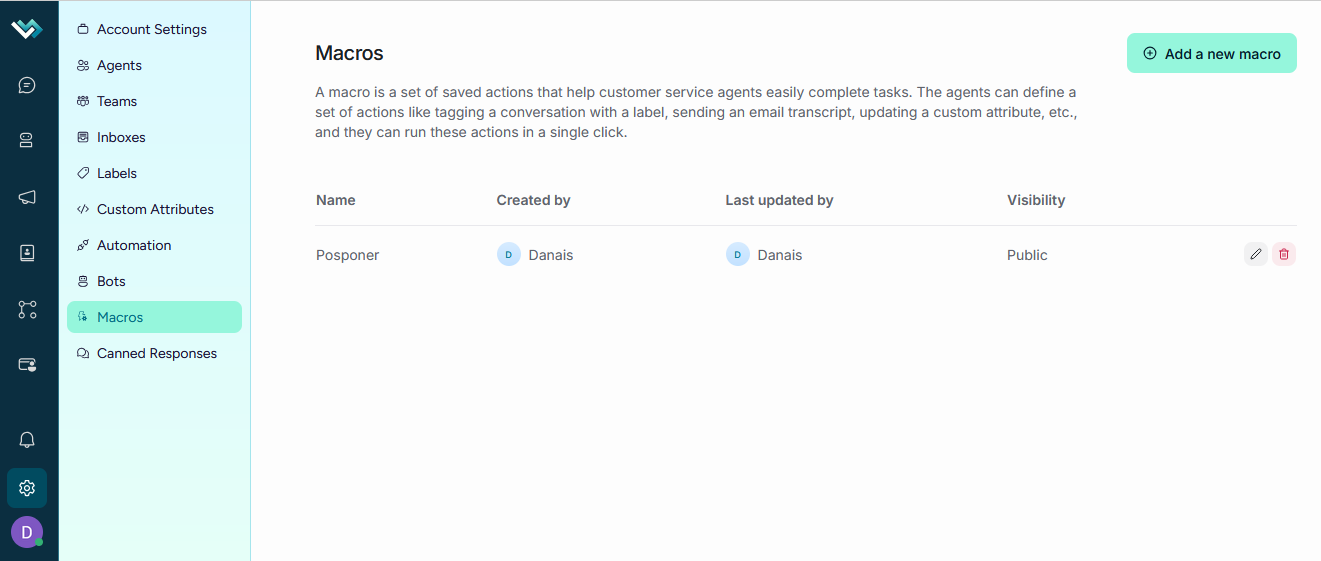
Creating/Editing Macros. Visual Workflow Editor
The system features an advanced visual editor that allows you to create/edit macros using a drag-and-drop interface:
Basic macro configuration:
- Macro name: Required field to identify the macro
- Visibility: Access control (Public/Private)
- Description: Optional field to document the purpose
Visibility system:
- Public: Available to all account agents
- Private: Only available to the macro creator
Visual Workflow Editor. Interactive Node Builder
The editor presents a visual system that simulates a workflow:
Flow elements:
- Start Node: Indicates the beginning of the workflow
- Action Nodes: Represent each individual action
- End Node: Indicates the end of the workflow
Drag and drop system:
- Visual reordering: Ability to reorder actions by dragging
- Visual connections: Lines that connect flow nodes
- Order indicators: Visual numbering of the execution order
Conversation Management Actions
The system offers a wide range of actions that can be included in macros:
Assignment Actions:
- Assign to Team: Automatic assignment to specific teams
- Assign to Agent: Automatic assignment to specific agents
- Remove Assigned Team: Removal of team assignments
Tagging Actions:
- Add Tag: Automatic application of specific tags
- Remove Tag: Automatic removal of tags
Conversation Management Actions Communication:
- Send Transcript by Email: Automatically send conversations by email
- Send Message: Predefined automatic responses
- Send Attachment: Automatically send files
- Add Private Note: Add internal notes
Status Management Actions:
- Mute Conversation: Automatically pause notifications
- Snooze Conversation: Schedule follow-up later
- Resolve Conversation: Automatically close conversations
- Change Priority: Automatically change priority level
Integration Actions:
- Send Webhook Event: Integrate with external systems
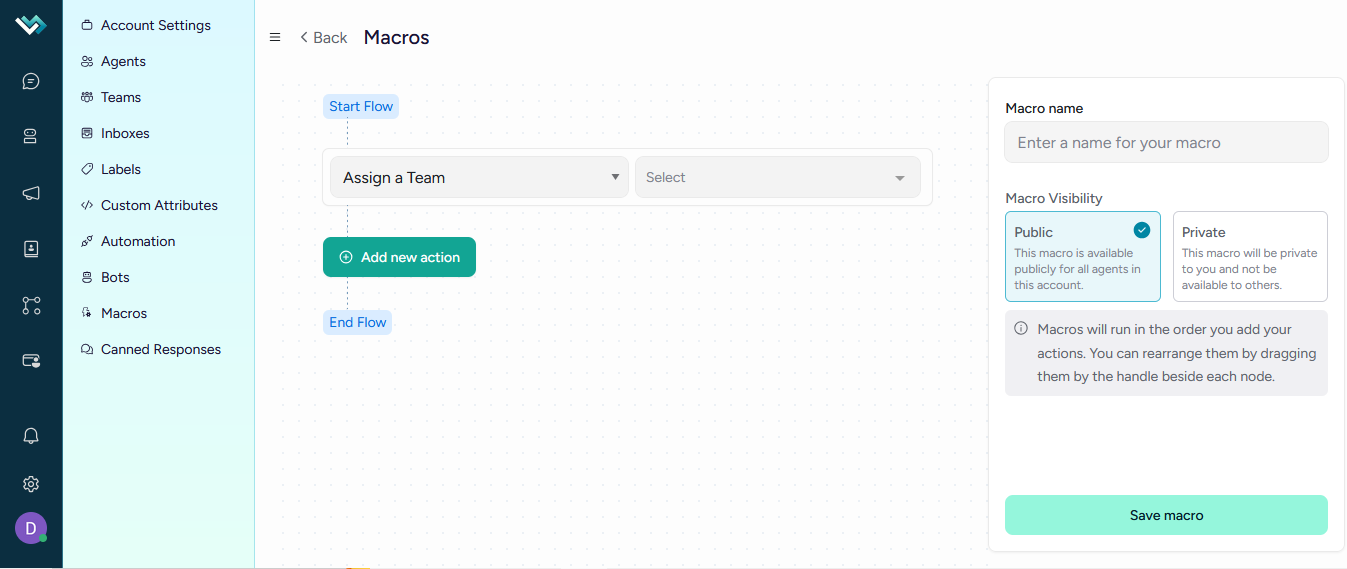
Dynamic configuration by action type
Each action has specific settings based on its type:
Assignment configuration:
- Team selection: Drop-down list of available teams
- Agent selection: Drop-down list of available agents
- Availability validation: Check for active teams/agents
Tag Configuration:
- Multiple selection: Ability to select multiple tags
- Tag search: Filter and search for existing tags
- Tag creation: Ability to create new tags
Message configuration:
- Text editor: Free-text field for custom messages
- Predefined templates: Access to common message templates
- Content validation: Verify appropriate content
Specific Use Cases
Rapid resolution macro
- Auto-tagging: Applying resolution tags
- Closing a conversation: Automatic resolution
- Follow-up note: Adding a private note
Escalation Macro
- Team assignment: Transferring to a dedicated team
- Priority change: Raising the priority level
- Email notification: Sending a transcript to the team
Follow-up Macro
- Postpone a conversation: Scheduling a follow-up
- Adding a note: Documenting the current status
- Changing tags: Updating the classification
The Macro Settings section in LBdesk provides an exceptional user experience that combines technical power with operational simplicity, allowing agents to create and manage automated workflows that significantly improve the efficiency and consistency of their customer service operations.
Predefined responses
It represents the control center for managing pre-written message templates, designed for agents and administrators to create, organize, and monitor standardized responses that significantly speed up the customer communication process. This comprehensive tool allows agents to instantly access predefined responses via short codes, improving operational efficiency and ensuring consistent communications.
├── Header
│ ├── Action Button: “Add Predefined Response”
├── Response Management Table
│ ├── Shortcode: Unique response identifier (with sorting)
│ ├── Content: Preview of response content
│ ├── Action Buttons
│ │ ├── Save Macro/Edit
│ │ ├── Delete
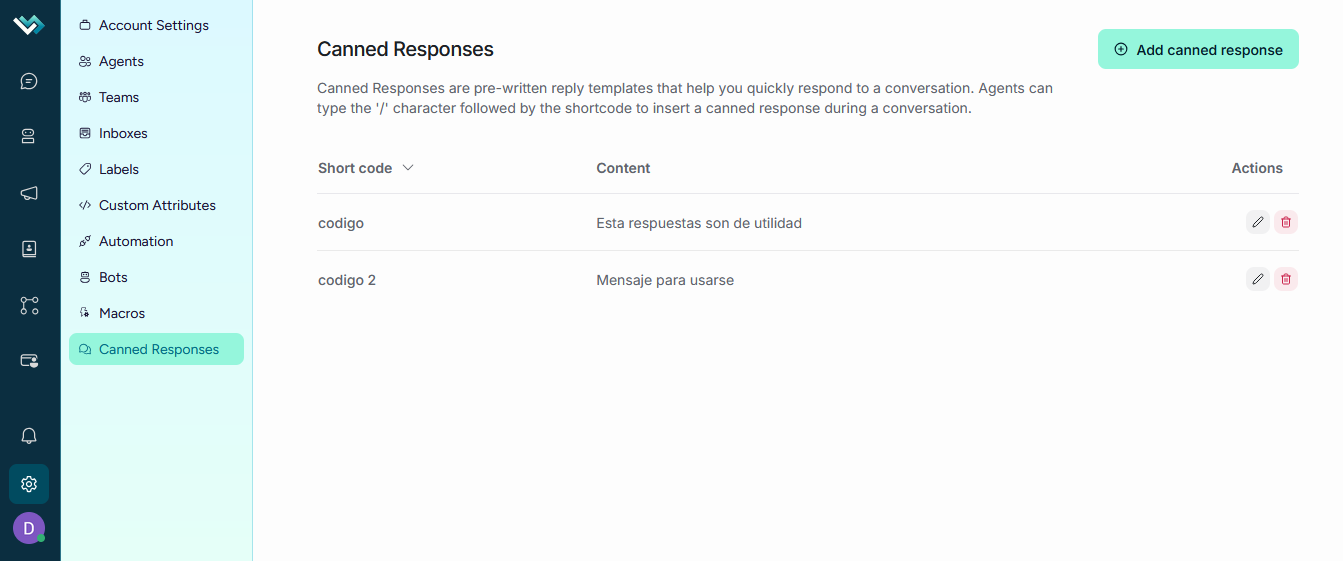
Creating/Editing Predefined Responses. Creating/Editing Modal.
Basic response configuration:
- Shortcode: Required field to identify the response (minimum 2 characters)
- Message content: Rich text editor for the response content
- Field validation: Verification that both fields are complete and validation of the shortcode by checking minimum length and uniqueness.
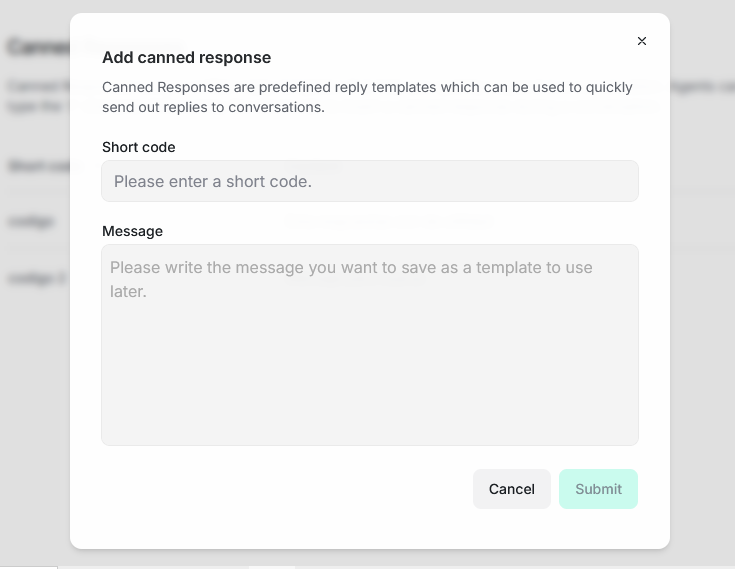
WootMessage editor
The modal integrates a sophisticated text editor that provides advanced formatting capabilities:
Editor features:
- Text formatting: Bold, italics, underline, and other styles
- Lists and bullets: Create ordered and unordered lists
- Links: Insert and edit web links
- Dynamic Variables: Insert customizable variables
- Emojis: Access the built-in emoji picker
Message editor integration
Predefined replies integrate directly into conversation editors:
Command trigger:
- Slash command: Triggered using the "/" character
- Smart search: Real-time filtering while typing
- Contextual suggestions: Display relevant replies
Selection interface:
- Dropdown list: Displays available replies
- Preview: Description of the content of each reply
- Quick select: One-click insertion
Search and Filtering System. Real-Time Search
The system provides advanced search capabilities.
Trigger point - Message Editor
Real-time search is triggered in two main locations:
1. In Existing Conversations
How it Works:
- Detects when the user types a message beginning with /
- Extracts the text after / as a search term
- Triggers the CannedResponse component with the search term
2. In New Conversations
How it Works:
- Same / detection mechanism
- Updates the search status in real time
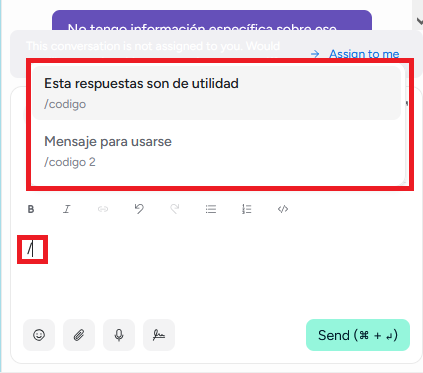
Search Technical Features
Automatic activation
- Activates immediately when typing / in the editor
- No need to press Enter or click search
- Updates in real time with each character typed
Smart search
- Searches both the shortcode and the content
- Case insensitive
- Sorts by search relevance
User Interface
- Mention Box: Displays results in a dropdown
- Keyboard Navigation: Up/down arrows to navigate
- Selection: Enter or click to select an answer
- Auto Replace: Replaces the editor text with the full answer
Search data flow
User types "/greeting"
↓
ReplyBox detects "/" and extracts "greeting"
↓
CannedResponse receives searchKey="greeting"
↓
Vuex dispatch ('getCannedResponse', {searchKey: "greeting"})
↓
API call: /canned_responses?search=greeting
↓
Backend filters: WHERE short_code ILIKE '%greeting%' OR content ILIKE '%greeting%'
↓
Results returned to the frontend
↓
MentionBox displays available options
↓
User selects response
↓
Text replaced in the editor
This implementation provides a seamless and efficient search experience that allows agents to quickly find the most relevant predefined responses as they type.